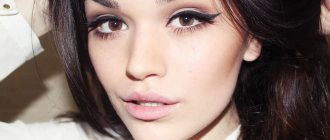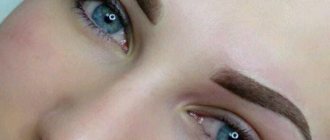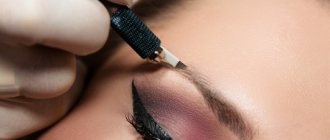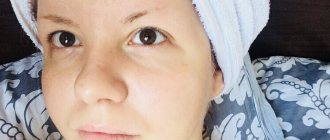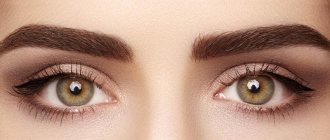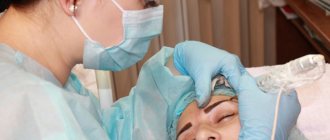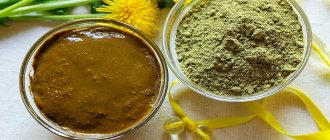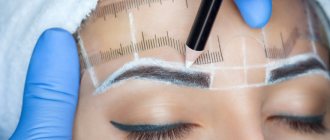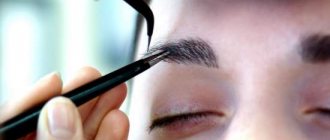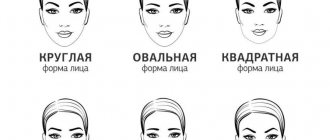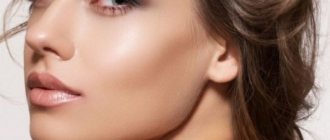To give their own image the missing expressiveness, women go to all sorts of tricks. This is the use of decorative cosmetics, coloring with paint and natural products.
However, the most lasting and visible effect can be obtained only by doing microblading, which is a type of permanent treatment. Such manipulations, when paint is injected through tiny punctures into the subcutaneous layer, allow for long-term results. The achieved effect, its safety and harmony depend on how correctly a woman takes care of her own eyebrows.
Eyebrow microblading - what is it?
Eyebrow microblading is a cosmetic procedure that involves applying a natural dye under the skin to give the desired shape and thickness to the appearance of the eyebrows.
Thanks to this technique of manual tattooing, you can create an expressive and at the same time natural shape of the eyebrows. There is no need to spend a long time applying makeup.
Eyebrow microblading: before and after photos
No special devices are used; this is a manual procedure, the effect of which depends entirely on the accuracy and professionalism of the master.
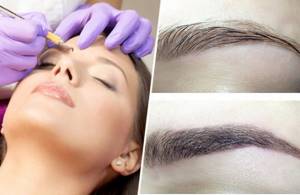
If your eyebrows are shaped the wrong way, microblading can help fix it.
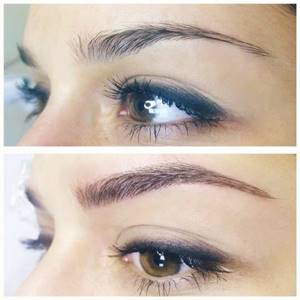
If there are almost no eyebrows for various reasons, this method will allow you to create natural eyebrows using paints.
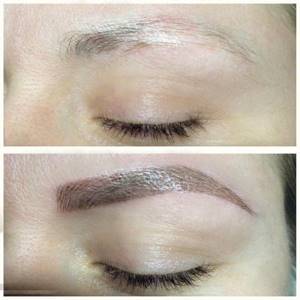
Unruly long hairs will look more neat.
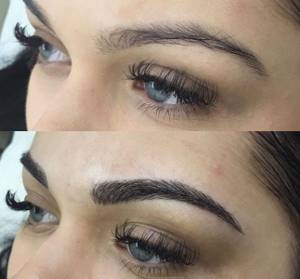
Over-plucked eyebrows can also be tidied up.
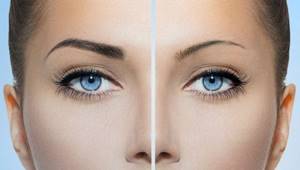
The main thing is to choose a good master.
Procedure stages and duration
- The master studies the client’s eyebrows and type of appearance, asks questions about the desired shape of the eyebrows and their color, and shows various models.
- The master cleanses the skin around the eyebrows, applies an anesthetic and waits 10-15 minutes for it to take effect.
- Next, the master draws the contours of future eyebrows with a cosmetic pencil. Hairs that extend beyond these contours are plucked out with tweezers.
- Various shades of paints are mixed, usually matching them to the hair color. In this case, the paint is usually chosen brighter than necessary, since after a few days the color fades.
- Using a manipulator, the master makes thin cuts that imitate hairs, filling the entire area of the eyebrow contours.
- At the end of the procedure, the eyebrows are treated with chlorhexidine and lubricated with Vaseline (or similar products).
The duration of the procedure depends on the experience of the specialist, but, as a rule, it takes 1-1.5 hours.
The video demonstrates in detail the entire microblading procedure from applying the anesthetic to obtaining the final result.
Microblading with shading: photo
Microblading with shading will not only give your eyebrows a natural look, but will also make them brighter.
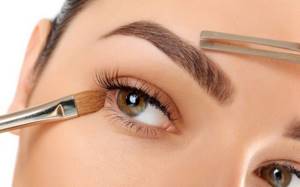
Any eyebrows will become perfect, as if they were simply drawn on with a pencil or tinted with mascara.
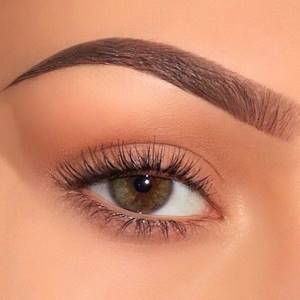
The artist can draw clear eyebrow lines on your face.
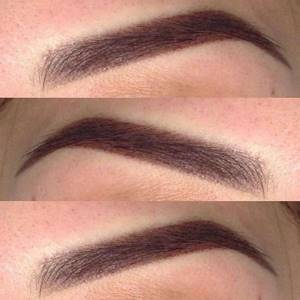
This is an ideal option for those who do not have natural eyebrow hair.
Contraindications and possible consequences
- period of menstruation (at this time the pain is stronger, the procedure will be more difficult to tolerate);
- pregnancy period (stress and pain can negatively affect the child);
- breastfeeding period (stress can lead to milk loss);
- inflammatory processes, colds, the period after surgery, exacerbation of chronic diseases (reduced immunity increases the risk of infection);
- the presence of moles in the eyebrow area (damage to them in some cases can lead to the development of melanoma);
- the presence of any skin damage in the eyebrow area (microblading can cause additional irritation, and the paint can also lie unevenly);
- allergy to paint components (consequences ranging from redness and irritation to anaphylactic shock are possible);
- chronic diseases, including mental ones (various complications are possible);
- poor blood clotting (severe bleeding may occur);
- tendency to form scars;
- oily and problem skin (there is a possibility that the effect will not last long);
- previously performed eyebrow tattooing (because of this, eyebrows may look unnatural, the color may be distorted).
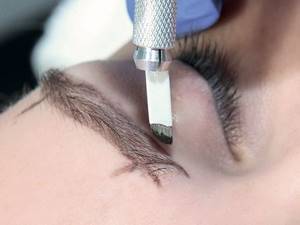
Neglecting contraindications is dangerous - this can lead to serious consequences for health and appearance or to poor quality results.
Photo of healing
Since microblading is a procedure that involves the use of tools and materials that injure the skin (needles, pigments), it will take some time for the “pattern” to heal before it looks like this:
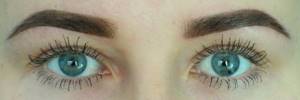
However, the appearance of tattooed eyebrows changes over time.
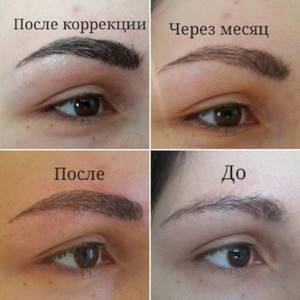
The microblading procedure cannot be called absolutely permanent.
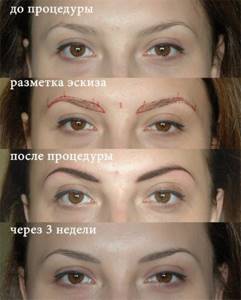
Over time, the shade becomes noticeably lighter.
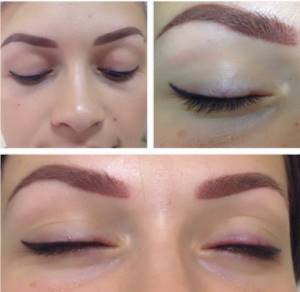
Therefore, adjustments are required over time to consolidate the result.
Pros and cons of the procedure
Advantages and positive aspects of the procedure:
- When choosing eyebrow microblading, find out what it is. Reviews indicate that the process is relatively short.
- No pain is felt due to the use of a thin needle.
- It is possible to avoid injury to the skin.
- One procedure is enough for perfect eyebrows.
- The pigment takes root well, thereby maintaining the natural appearance of the eyebrows.
- The needle is inserted shallowly.
- There is no swelling after the procedure.
- It is used regardless of the person’s age, the main thing is that there are no contraindications.
The procedure is unique because it allows you to do a biotattoo once and not have to worry about the appearance of your eyebrows for a long time.
As elsewhere, this technology has its drawbacks or imperfections:
- Expensive.
- A small number of professional masters due to the novelty of the procedure.
- Microblading should be done periodically, preferably every 2-2.5 years.
- The final effect appears after 1 month, after the skin has recovered.
- During the process of eyebrow microblading, unpleasant and sometimes painful sensations may occur.
- After the procedure, it is necessary to properly care for your eyebrows.
- If there are contraindications, microblading becomes impossible.
Which is better: eyebrow tattooing or microblading?
The first results of tattooing and microblading are not so obvious. Both methods are used to achieve pronounced, defined, beautiful and fashionable eyebrows. The result lasts for almost the same period of time. And the care rules are identical.
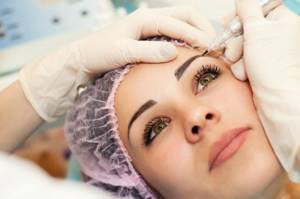
To understand what is better and choose a more suitable procedure for yourself, you need to understand tattooing and eyebrow microblading - what it is. People's reviews do not always make it possible to clearly distinguish the boundary between these two methods of simulating eyebrows. Therefore, it is necessary to understand what the essence of each technique is.
Tattooing allows you to create a stable eyebrow pattern on the skin in the form of an ideal and clear arc. This effect is achieved by introducing pigment under the skin, or rather, into the upper layer of the epidermis. But the dye does not spread, but crystallizes, forming a kind of capsule. As long as it is intact, the contour of the eyebrows will not change.
Different tattoo techniques:
- Hair technique. Its essence is in carefully drawing each hair to obtain the most realistic eyebrow line. The difference from natural tattooing is that tattooing allows you to get the desired shape and color that matches the ideal one. The hair method is quite complex. It is not suitable for everyone and requires a highly qualified specialist to implement it. With very light eyebrows and eyelashes, this method will not have the desired effect.
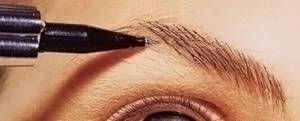
- Shot ─ this is a partial drawing and shading of hairs. Soft shading allows you to create a background that already makes the eyebrow brighter and more expressive. Further drawing of the hairs can lengthen the eyebrow or change its shape. This method is equally suitable for both light and dark eyebrows. And the result can last 3 years.
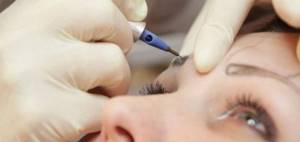
- Shadow technique ─ This is also a shading that imitates the hairline, the best option for light or red shades of hair.
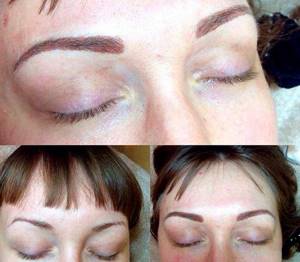
The difference in techniques is not only in the technology of applying shading or drawing, but also in the method of introducing a dye under the skin layer. Tattooing is performed using devices similar to those used in tattoo parlors. But delicate work requires manual application. This procedure is quite traumatic.
The areas of skin that have been tattooed heal no earlier than after 5-10 days.
Subsequently, prolonged exposure to sunlight, exposure to sea water, and skin cleansing using harsh scrubs are not recommended.
Feedback from people boils down to the fact that microblading and tattooing differ in the method of application. But in order to understand this topic more deeply, you need to understand what it is - eyebrow microblading.
At the very beginning, the master makes a pencil sketch of the future eyebrow, taking into account the features of the face, the color type of the client’s appearance, as well as his personal wishes.
If all organizational issues have been resolved, the leather is subjected to special treatment. Antiseptics, anesthetic cream or gel are used. Next, within the boundaries of the drawn outline, strokes are made with a special blade and filled with pigment.
This is a type of hair tattoo, implemented using slightly different methods. With microblading, the dye is injected using a spatula blade. The hairs are clearly visible on the skin, and the residual pigment is immediately removed.
The drawn hairs are obtained at a strictly defined length and fineness. No spreading of paint occurs, since it is within strictly defined boundaries.
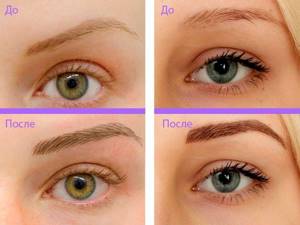
Good specialists who clearly know what microblading is, advise getting a tattoo for fair-haired people who want to have a clear contour and beautiful eyebrows, and microblading for dark-haired people.
Reviews indicate that it is impossible to say so clearly which is better. Handmade work is always more valuable, but sometimes it is simply not necessary.
When to make a correction
Is eyebrow correction necessary after microblading? The answer to this question is clear: “Yes”! Complete tissue restoration occurs within a month. By this time, the final result of the master’s efforts appears. You can assess the degree of pigment survival and work on areas that need additional attention.
Advice. The first eyebrow microblading correction should be carried out no earlier than 40 days later, but you shouldn’t delay a second visit to the salon either.
After the correction, follow the same care instructions that the master gave at the beginning. The healing period passes much faster, because not all the skin under the eyebrow is exposed to manipulation, but only problem areas.
Is it possible to do microblading during pregnancy and lactation? Sometimes in a salon’s contract for the provision of services you can find a clause stating that the procedure is not recommended for pregnant and lactating women. In fact, the dyes and anesthetics used during the session do not enter the bloodstream and have no effect on the child’s body.
If a woman’s eyebrows are naturally very light, she is forced to dye them to ensure an even tone and visual density. You can dye your hair with permanent dye only after the skin has completely healed, no earlier than 1.5-2 months after the procedure.
Modern cosmetology works wonders. But the pointing pen is not a magic wand. Even if you trust the best master, you should not shift responsibility for the result onto him. The degree to which expectations will be met will depend on how carefully the woman takes care of her eyebrows after microblading.
Materials and tools for microblading
Professional microblading artists are currently in demand in beauty salons. They may also engage in private activities. But here it is not enough to take special courses and be able to draw well. Creating a high-quality result depends on the professionalism of the master, but not only.
Proper use of professional equipment, as well as high-quality consumables, is of no small importance.
Apparatus
The cost of a device used for microblading varies from $300 to $2000. It is believed that the highest quality cars are from German and Taiwanese manufacturers. Such equipment is characterized by high power. Thanks to this, vibration of the needle does not interfere. In addition, there are American devices on sale that cost $1,200 or more.
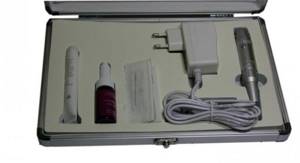
China produces cheap equipment, and therefore it will not last long. Despite the many functions it performs, it quickly breaks down. If a master performing eyebrow microblading plans to seriously engage in this activity, then he will have to purchase high-quality equipment.
In order to eliminate errors due to technical capabilities. It also happens that, looking at the result, it becomes not entirely clear what it is. Reviews from satisfied clients are the best reward for a true master. Therefore, he has no room for error.
Needles
When choosing equipment, not only its functionality is important. But also the strength of the vibration of the needle. If the vibration is too strong, it interferes with the drawing. At best, this will result in unevenness, and at worst, damage to the skin.
The needle is the most important element when performing manual tattooing. It comes into direct contact with the skin and should be disposable. This condition must be met to avoid infections and ensure client safety.
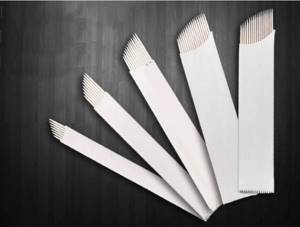
The diameter of the needle is selected depending on the nature of the pattern. For the smallest details, “closed” needles are used. Their tip looks like a bunch. Their use will allow you to get a high-quality result from many clear, small details.
A high-quality needle meets European standards . High demands are placed on such products during production. Storage in individual packages is a mandatory requirement. Immediately before the procedure, the needle is subjected to gamma irradiation to ensure sterility.
Handle
A pen for microblading, also known as a handpiece, should be light and easy to use . If the nozzle at the tip opens well, then there will be no problems with installing the needle and securing it securely.
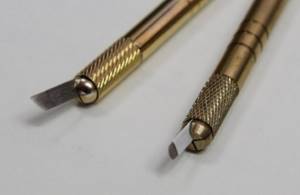
Using a manipulator pen, pigments are introduced into the top layer of the skin. The needle passes to a depth of 0.5 mm. Most people realize what it is - manual tattooing. But reviews from people who have tried eyebrow microblading prove that the wearing time of the design does not decrease just because the procedure is manual.
Pigments
In addition to additional needles, the master will also need other consumables: pigments, stencils. Dyes deserve special attention. A professional needs to have more than five popular shades. Quality pigment paints can always be mixed to achieve the desired color.
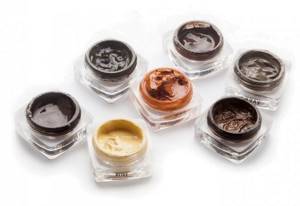
If it is not possible to regularly update them, you need to purchase at least samples. Usually a small jar is needed for several procedures. Gel pigments are considered the best dyes , as they can be shaded without additional effort and are easy to apply. This allows the master to create a clear drawing.
For people prone to allergic reactions, anti-allergenic pigments are produced. They cost more, but they help prevent disastrous consequences.
Consequences of microblading
Due to the fault of the master or salon
For your information! Choosing a beauty salon with inexperienced professionals or, even worse, performing microblading at home can lead to the development of such unpleasant consequences as:
- The development of allergic reactions to anesthetic drugs or to the paint itself. In all cases, this is the fault of the master, who must first send the client to the clinic to take allergy tests for the materials used.
- The appearance of large scars. This is a consequence of a predisposition to the formation of keloid scars, when the tissue at the site of open injuries is too quickly and in large volumes replaced by connective tissue. This phenomenon is also on the conscience of the master, who did not warn the client about such consequences and did not send him for additional examination to identify this pathology.
- Quick pigment leaching and complete absence of color changes. In the first case, it was a mistake to use a smaller amount of dye or use low-quality paint. The second is the use of a pigment that is too light in color when working with clients whose natural hair color is already too light.
- Injury to the hair follicles and the cessation of hair growth as a result in different areas of the eyebrow. In fact, this happens extremely rarely, since the follicles lie deeper than the master’s microblade penetrates. But with too much pressure, this is possible, and only after repeated microblading over several years.
Due to the fault of the patient and improper care
Such consequences are the fault of the salon worker. But the fault may also lie with the patient himself.
You should know! First of all, this concerns allergic reactions and various side effects due to ignored contraindications.
Such effects may be:
- severe uncharacteristic swelling;
- heavy, unstoppable bleeding;
- rapid washing out and fading of pigment;
- infectious infections;
- long healing;
- uneven distribution of pigment.
Irreversible consequences
Some consequences may be persistent and even irreversible , but they cannot be identified immediately and will only become apparent after time.
Note! One of these complications is uneven contour and pattern.
Over time, if the pigment fades completely, this may also go away.
But when treating large areas using dark-colored paints, pigment may appear on the eyebrows for many years.
And if the dye can still disappear over time or can be removed using cosmetic methods, then the scars usually remain forever.
We are talking not only about large keloid scars, but also about microscars that remain in place of the drawn hairs.
Such phenomena may not be noticed under natural eyebrows.
But they can make themselves felt during subsequent tattooing : scar tissue reacts unpredictably to the introduction of pigment.
In the best case, it will simply be washed out completely, and in the worst case, these scars will become even larger, and the pigment will spread in the tissues and will extend beyond the contours of the hairs and the eyebrow itself.
What not to do before the procedure
Before eyebrow microblading, preparation is carried out:
- You can't take antibiotics. They have the property of blocking pigment, which subsequently will not take root.
- You should not drink alcohol, it thins the blood. Otherwise, the procedure will produce ichor, which will negatively affect the final result.
- You should postpone visiting the beach or going to the solarium so that your skin does not become rough from exposure to ultraviolet radiation. In this state, she does not perceive pigments well.
- You cannot pluck your eyebrows for 2 weeks so that the artist can see their natural state.
- Before the procedure, you will have to give up coffee and other caffeine-containing products.
These restrictions must be followed before the eyebrow microblading procedure. And a good master should remind, tell in detail, explain what it is. And what consequences can result from neglecting safety precautions?
Reviews from satisfied clients after the successful completion of the procedure and obtaining the long-awaited effect will not take long to arrive. Moreover, they will be a pleasant addition to material incentives, as well as loud advertising.
How to do eyebrow microblading
Before the session begins, a good master listens to the client’s wishes regarding the shape and color of the eyebrows. Talks about his vision, coordinates adjustments, taking into account the individual characteristics of the client. Tells in detail about eyebrow microblading and what it is. Feedback from its customers is also demonstrated to prove the words.
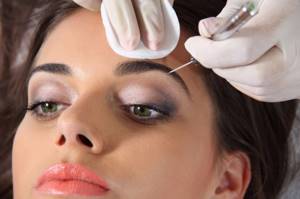
After developing an action plan, the master begins work:
- Unnecessary hairs are removed from the working area.
- The skin area is disinfected with a special solution.
- Pencil sketches are made to give an idea of the new eyebrow shape.
- The area around the eyebrows is anesthetized to minimize pain.
- The introduction of pigment under the skin using special instruments is the main stage of the procedure. It is important to constantly monitor the depth of pigment penetration to achieve a natural result. The dye is introduced using one of two types of techniques.
- To obtain the desired result, the procedure is repeated up to 5 times.
Your eyebrows may feel swollen for a while after microblading, but this is a completely normal reaction. Upon completion, the master gives recommendations for care to obtain the expected result and preserve it for as long as possible, which you will have to carefully follow.
Hair or European technique
The hair microblading technique for eyebrows involves shaping the eyebrows with small strokes. The specialist selects the pigment and thickness of the strokes in such a way as to create beautiful eyebrows as close to natural as possible. It is very difficult to distinguish a high-quality drawing from real eyebrows.
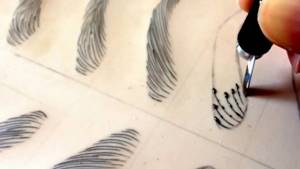
European ─ also known as mannequin hair is that the hairs are drawn in one direction, usually of the same length and thickness. The result is an ideal, clear shape. In reality this does not happen.
Eastern technology or 6D
Eastern technology is the option closest to natural. Different strokes are drawn to obtain the eyebrows of the desired thickness and shape. In terms of time, this procedure lasts longer than the European technique. And not all masters master it. But the natural result exceeds expectations.
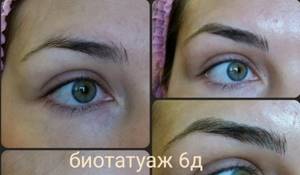
6D ─ represents the careful drawing of each stroke individually. The work is painstaking, but it allows you to create natural, beautiful and, most importantly, voluminous eyebrows. For a unique result, no machine is used. Everything is done only by hand.
Shadow microblading or shading
Shading or shading is also the introduction of pigment to a shallow depth. If you are interested in shadow microblading of eyebrows (what it is and reviews), then many say that it looks artificial, like a tattoo.
But time does not stand still. Masters are constantly improving their skills, and advanced specialists will never turn their client into a doll, so they try not to draw very clear lines.
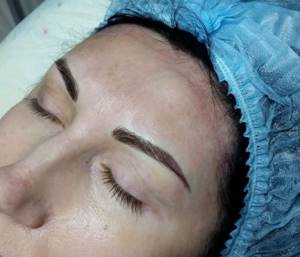
Toning appeared recently. The finished result should look as if the eyebrow was tinted with shadows or a pencil. It is very difficult to work in this style. You need to remember one simple rule: there should be no bright frames.
Reconstruction
Eyebrow reconstruction allows you to achieve the following results:
- make long-term shape correction;
- hide gaps and scars;
- create an eyebrow shape that will be in harmony with the aesthetics of the face;
- create an imitation of natural eyebrows;
- achieve results for several years.
How long does microblading last?
How long the result will last after microblading depends on several reasons:
- Oily skin. For oily skin, pigment paint dissolves much faster.
- Due to exposure to solar radiation, the pigment becomes less saturated, because of this it is recommended to use protective agents.
- The use of scrubbing cosmetics shortens the wear time of eyebrows.
The maximum duration of the effect is 18-20 months , the average is 10 months. Not only the characteristics of the skin, but also proper care play a huge role. After time, those who wish undergo correction, which allows them to give their eyebrows more refinement. Experts advise making adjustments at least once a year.
Rules for caring for the formed crust
The formation of crusts, when the skin begins to itch and itch, is an inevitable stage of the recovery process. They appear from the third to the fifth days and last about a week.
We recommend reading: What is the best way to paint your eyebrows: pencil, eye shadow, paint, henna?
It is strictly forbidden to remove crusts forcibly; you must wait until this process is carried out independently.
Otherwise, there is a high probability of the following negative consequences:
- skin infection;
- convergence of pigment, resulting in uneven tone;
- prolongation of the recovery period.
It is important to take careful and timely care of the crusts:
- Chlorhexidine treatment;
- applying cosmetic Vaseline;
- acupressure with the tip of a cotton swab to relieve constant itching;
- Rubbing, forced peeling, touching with hands, and using water are prohibited.
Balanced moisture in the brow ridges during this period is the key to uniform healing and obtaining harmonious-looking, natural brow ridges.
Where is the best place to get eyebrow microblading?
For those who want to have perfect eyebrows, it is better to contact a cosmetologist. The master's arsenal consists of different technologies and techniques that allow one to give a clear shape, change color, and create the illusion of thickness.
This is exactly the result that eyebrow microblading allows you to achieve. What it is, you can draw conclusions from the reviews of those who have already tried it.
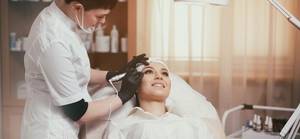
For those who do not yet know what eyebrow microblading is, the right choice is a professional salon with a good reputation
Similar procedures are performed in beauty salons staffed by professional cosmetologists. They are sure that the procedure cannot be done at home. Having turned to professionals in a specialized salon, the client must be confident in the correctness of his choice.
Home conditions are not at all suitable for such procedures. In this case, it's not worth the risk. All norms and rules will certainly be observed in the salon.
Upon completion, the master will advise you on skin care after eyebrow microblading. The final result depends 100% on the master, his skills, abilities, and experience. Therefore, you need to visit well-known salons, whose specialists are famous for their professionalism, extensive experience and positive reviews.
Possible consequences
- Mini-incisions are the same as eyebrow microblading. If you believe the published reviews, then this procedure is presented as painless. But the skin is cut with a blade, then pigment is injected into the wounds. The process is accompanied by bleeding and microscars. So it cannot be said that microblading is painless.
- No promised naturalness! The most powerful argument is the naturalness of the result obtained. The successful outcome of the case can be judged only after 4 weeks, after the damaged areas have completely healed. And not immediately after the procedure, which is usually shown to clients. As the incisions heal, microscars appear. They are visible in good lighting. The lines thicken and sometimes blur. It also happens that the applied strokes acquire a gray tint. You can make a correction, but there is a risk of only making the situation worse.
- Pigment dye injected under the skin remains there for some time. But it can also fade. This process is individual and depends on many factors. They influence:
- peeling,
- smoking,
- hormonal imbalance,
- taking certain medications,
- sun rays and many other factors.
- If the pigment is introduced superficially , it will leave the skin within 1 month.
The ugly truth about eyebrow microblading! This is what permanent makeup artists hide from us
I recommend reading it for those who want to know the truth about eyebrow microblading. The author, a master from Germany, Maria Galaburda, emotionally but truthfully reveals the essence of this procedure. In conclusion, there is a video from Elena Nechaeva, the owner of a chain of permanent makeup salons, talking about the pros and cons of microblading.
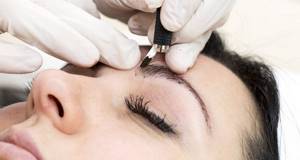
I remained silent for a long time, observing the principles of professional ethics and democratic freedom of action. However, the sense of responsibility towards clients and beginners, as well as their obvious need for protection from mistakes, compels me to speak and act.
Since the end of 2014, Germany has been experiencing a real boom in eyebrow tattooing. MICROBLADING is advertised on every corner: “the most natural, modern, innovative way” to miraculously transform your face. This new method of tattooing “guarantees an excellent result with the finest, naturally styled eyebrow hairs.”
The hairs created in this way are supposedly impossible to distinguish from one’s own. And the procedure itself is absolutely painless and non-traumatic, and therefore MICROBLADING is strikingly different from the hitherto used “conventional hardware method,” which adherents of MICROBLADING call barbaric and antediluvian. After all, only with the help of MICROBLADING is it possible to achieve ideal results and get perfect and natural eyebrows, which then simply fade and completely disappear in 8-12 months.
Recently, MICROBLADING has new names: eyebrows using the 3D or 6D technique. (No one has ever been able to explain to me what this means...)
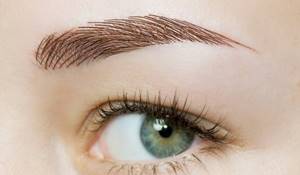
This is marketing. And now - the facts:
“INNOVATIVE”?
The “new and modern” method is nothing other than the ancient Chinese technique of eyebrow tattooing. From time immemorial, it was used mainly in poor Chinese neighborhoods, while the necessary material can be purchased quite cheaply. Thus, the poor could also afford to get a tattoo. This is such an innovation...
We must also not forget that the skin of Asian women is strikingly different from our Northern European skin. Asians have elastic skin with a yellowish tint and a small amount of red pigment. Our skin is loose, vascular, often with weak connective tissue. For this reason, the skin of European women reacts completely differently to the application of pigments and heals differently.
WHAT IS “MICROBLADING”?
What does the word MICROBLADING mean? That's right, translated from English these are “mini-cuts”. And this is exactly what happens during the procedure. A special blade attached to a holder is dipped into the pigment, after which it cuts the skin. Then pigment is applied and rubbed into the eyebrow surface treated in this way (the so-called “mask”). This procedure is presented as non-traumatic and painless.
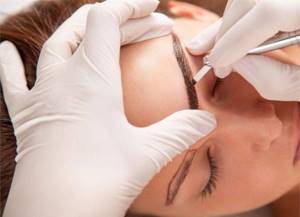
Now the facts:
With permanent makeup (and microblading is nothing more than permanent makeup, that is, introducing pigment into the skin for a long time), pigments are implanted into the middle layer of the skin, the dermis. The dermis is located between the top layer of skin (epidermis) and subcutaneous fat. To get into the dermis, you need to overcome the epidermis. When working with a permanent makeup machine, the following happens: The needle pierces the skin (several thousand times per minute), enters and exits it, thus creating a huge number of mini-punctures and each time releasing a small amount of pigment into the skin. In other words, we get the effect of perforated leather.
What happens with microblading?
The skin is cut with a blade down to the dermis layer, like a scalpel. Pigment is then injected into these cuts. What is an incision? This is damage to the top layer of skin, accompanied by bleeding and scarring. If the surgeon does not suture the skin after the operation, it will heal roughly, widely and unsightly, since a large amount of connective tissue forms at the site of the cut in order to quickly eliminate the injury, “fill it with rescue paste.” But while we are dealing with MICROblading, in our case we are, of course, talking about MICROscars...
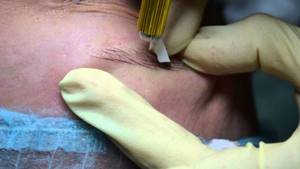
I often read in microblading advertisements that the procedure is painless and the skin does not bleed. This is wrong! Of course, it hurts, because the skin is cut: try cutting your skin with a razor, how can it be painless? And naturally, it bleeds, since there are blood vessels in the dermis. If no blood appears during the procedure, this can only mean one thing: the work is carried out too superficially and the pigments are introduced into the epidermis. And this layer of skin is renewed every 28 days. Together with the dying epithelial cells, the pigments will come out of the skin and after a month there will be nothing left there.
Naturally, I tried MICROBLADING myself. Some of my friends and relatives selflessly provided me with a “field for experimentation.” So I have a great understanding of this method and its implications. Fortunately, I carried out my experiments not on faces, but on other parts of the body with similar skin and subsequently removed the traces of my experiments with a laser.
“VERY NATURAL”?
The result is supposedly very natural. This is the strongest argument used in advertising microblading. “The hairs are arranged in a very natural way and are almost impossible to distinguish from your own eyebrow hairs.”
Naturally, photographs of fresh, just completed work are used in advertising. And I must admit that they look very, very beautiful and natural. And this is where the catch lies! Because only by the healed result (3-4 weeks after the procedure) can one judge the procedure performed. Immediately after the procedure, the damaged skin tightens and shrinks (a natural reaction to injury) and the lines applied look very thin and beautiful. However, the following happens afterwards:
The wounds (incisions) are healing. Microscars appear (they are very clearly visible under a lamp and magnifying glass). The introduced pigment migrates into the dermis and settles. Because of this, the lines become thicker and partially blurred. Since the skin was bleeding during the procedure, the added pigment is partially mixed with hemosiderin (iron-containing pigment formed during the breakdown of blood) and is deposited in the skin for a long time. This is the reason why hairs applied using microblading so often acquire a bluish-gray tint.
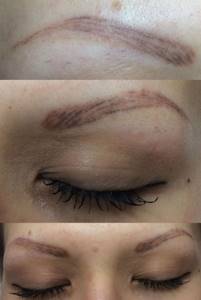
In order to apply uniform, beautiful lines at the same depth of the skin, the master must have enormous experience and a calm, steady hand. And this is a rare case in microblading (I will explain below). As a result, we have restless, often dotted lines, since the pigment is introduced partly into the dermis, partly into the epidermis. And sometimes, alas, it goes deeper... In this case, the master suggests carrying out a correction procedure to “finish” the hairs. Unfortunately, such corrections often only aggravate the situation, since it is extremely difficult to hit the same hair with a thin blade. And then new parallel lines of similar quality are formed.
“FADING WITHOUT A TRACE”?
Permanent makeup is the introduction of pigments into the middle layers of the skin (dermis) for a long time. And it doesn’t matter at all how these pigments are introduced, with a device or a blade on a holder. Once the pigment is in the dermis, it remains there for a certain time.

Pigment fading is a highly individual process and depends on many different factors. Metabolism, sun exposure, peelings, nutrition, smoking, hormones, medications... All this plays a role in removing pigments from the skin. On average, we can say that a tattoo lasts from 1 to 5 years.
If you introduce pigments too superficially, they will come out of the skin within a month, along with dead epidermal cells. If they are implanted too deeply, they will remain in the skin for a very long time, perhaps forever. That's all.
“IDEAL FORM”?
Most microblading adherents measure and draw a sketch of their eyebrows according to the “golden ratio” principle, using a special compass. In this way they supposedly create the ideal eyebrow shape.

Beautiful words with ugly consequences... Because: you can’t just draw eyebrows for a client, guided by geometric formulas! Each person is unique and requires an individual approach. A professional is obliged to consider each client as a whole, taking into account his style, figure, height, facial expressions, habit of applying makeup, etc., etc. I will not tire of repeating: you need to draw a sketch for permanent makeup only by hand and without any measurements or, especially, templates. I allow my beginning students to take only one measurement: when checking the length of their eyebrows. The rest is drawn only “by eye”.
"PROFESSIONALLY"??
MICROBLADING is now being done on every corner. Anyone who does not offer MICROBLADING is behind the times. Eyebrows are cut by all and sundry. Why? It's simple:
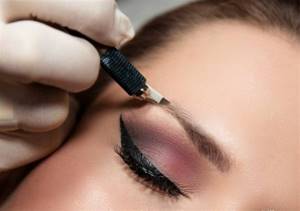
A solid, professional education to become a permanent makeup artist takes quite a long time, is expensive and involves considerable investment in equipment and working materials. But training to become a MICROBLADING master lasts 2 days, costs 1000-1500 euros, and you can buy a set for work for 300-400 euros. Let's face it: what can you learn in a two-day group seminar? Just yesterday a man was doing a pedicure and manicure, and today, after a two-day seminar, he is cutting the skin on his face with a blade...
Just for comparison: in order to give vitamin injections in Germany, for example, you must have at least a naturopathic diploma (2-3 years of study and successfully passed the exam at the health department). And to cut eyebrows, a two-day seminar is enough... Irresponsible and beyond all understanding...
ADDITIONALLY
I have been observing the development of the “MICROBLADING” phenomenon in Germany for 1.5 years. During all this time I have not seen ANY BEAUTIFUL LIVED WORK. None. There is no naturalness, no ideal fine lines. Occasionally, I saw more or less successfully healed works presented for viewing 1-2 months after the procedure. However, in the following months, these more or less successful lines still turn into incomprehensible blurry spots.
“Microblading victims” constantly come to us to have their terrible results removed. Desperate, disappointed girls and women who fell for beautiful photographs of recent works and now walk around with a disfigured face. We are constantly removing this “beauty”. It hurts. It costs money and takes a long time. It gets on your nerves. These clients first paid for MICROBLADING, then for its removal, and then they will pay for a new tattoo (if they ever decide to entrust their face to someone again).

I am often accused of lacking objectivity. They say that the hardware method of tattooing also produces quite ugly results. Yes it's true. We often remove the terrible results of hardware PM. There are enough crooked masters in any method. BUT: This in no way justifies further facial disfigurement, no matter what method: with a machine, a blade or a fish bone!
STOP THIS MADNESS!
Dear clients, lovely girls and women! Don't be fooled by pretty pictures. Think very carefully whether you are ready to give a lot of money, time and nerves to conduct this experiment on yourself.
Go for permanent makeup only to experienced and talented artists and - PLEASE! - always ask to show you photographs of the master’s LIVED works. They are VERY different from the photographs of recent results. I perform approximately 1000 PM procedures per year, I know what I'm talking about...
There are very good permanent makeup artists in Germany. Experienced, serious colleagues who adore their work and do it with love and great dedication. As a rule, such masters do not engage in aggressive advertising; they readily show photographs of healed work and honestly and openly talk about the possible risks and consequences of a particular procedure. These are the kind of masters you should trust with your faces; their hands will not harm you.
Would you consider microblading your eyebrows? Be sure to share in the comments!
Source
Shall we turn on some music to set the mood?
Now playing:
Open Kluber FM website | iOS app | Android app
Is it possible to do microblading during pregnancy?
In the early stages of pregnancy, eyebrow microblading can be done, but with caution. It would be a good idea to consult a doctor, or at least a good specialist.
Recommendations:
- The procedure can be done for the first time no later than the 4th month.
- A repeat procedure is allowed no later than the 5th month.
- Correction can be made no later than the 7th month.
In this case, safe, gentle means are used. In the later stages of pregnancy, it would be reasonable to refuse the procedure and think about the health of the woman and the child developing in her body.
Eyebrow care after microblading in the first days
Every girl or woman who decides to have eyebrow microblading should know what it is and how to care for the skin afterwards. Reviews indicate that this stage is of great importance, influencing the formation of beautiful eyebrow arches and consolidation of the result.
Care includes:
- Using ointment to quickly heal wounds.
- After the ointment, Vaseline is applied to the inflamed areas.
- Vaseline is applied 2-3 times a day.
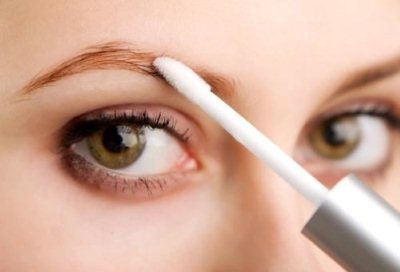
What not to do:
- Use cleansers.
- Use decorative cosmetics for eyebrows.
- Take baths with hot water.
- Visit swimming pools and saunas.
- Give your body exercise.
- Eat spicy food.
Stages of care after microblading
How long does eyebrow microblading last?
Trends in healing eyebrow skin care after microblading may change from time to time due to continuous improvements in techniques, equipment and scientific progress. The client receives final instructions for action from his master.
Immediately after the procedure
Healing care begins in the salon. After completing the work, evaluating and photographing the result, the master applies a thin layer of medicinal ointment to the exposed surface. This will be one of the means listed above. In studios, D-Panthenol is more often used.
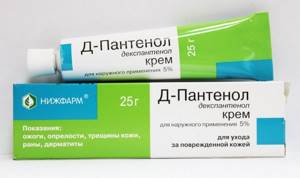
D-Panthenol accelerates skin regeneration
The healing preparation is left until completely absorbed.
Please note! When healing tiny wounds, crust formation is inevitable. The main task is to prevent it from becoming too thick.
The wet shine of your hair is the only thing that gives away a visit to a microblading studio. The skin should not become very red or swollen.
If there is a tendency to allergic reactions, antihistamines are prescribed.
First 2 hours
The microblading procedure, although slightly, does injure the skin. In the first 2 hours, liquid will be released from the microdamages - ichor. It can be transparent, but most often it is colored in the color of the pigment introduced into the upper layers of the dermis.
The main thing is to prevent the lymphatic fluid from drying out. Otherwise, when it dries, a dense film will appear, which will prevent the even distribution of the dye.
The eyebrows are blotted with gentle, light movements using a cloth lightly moistened with an antiseptic.
Attention! In the first hours, you should not use cotton pads - the smallest fibers can get into the wound and cause additional discomfort.
24 hours after the procedure
A couple of hours after the session you should wash your face. Use only liquid products. Children's gel or foam for sensitive skin is suitable. Damaged areas should be washed quickly and carefully. You can’t do without this, because thick ointment promotes the sticking of tiny dust particles. Then the skin is dried with a disposable paper towel. Apply a thin layer of Vaseline to clean eyebrows. You should wash your face in this manner every 2.5 hours.
Care for 2-7 days
The pigment does not fully appear for long in the first week, which makes it possible to evaluate the brightness of the final color. Then, as it heals, the skin thickens and the richness is dulled.
Tissue regeneration is accompanied by itching. It appears on day 2-3 and lasts until complete healing.
Important! Even if your eyebrows itch unbearably, you should never touch them!
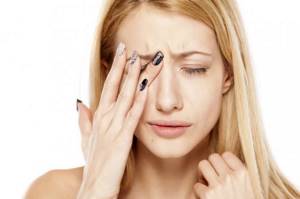
It is forbidden to scratch eyebrows
The appearance of crusts is a natural process, they should also go off without outside help.
In order for the areas where manipulations were carried out to itch less, it is important to prevent them from drying out. If necessary, the surface should be smeared with cosmetic Vaseline.
Otherwise, care differs little from daily hygiene procedures. Washing is performed in the morning and evening. Use mild cleansers and disposable towels.
Most often, the crusts disappear after 1-2 weeks. It depends on the skin type, the speed of regeneration processes and the accuracy of following the specialist’s recommendations.
When properly cared for, crusts form a barely noticeable microfilm. At the beginning of the week, you can replace Vaseline with healing ointments, then this is not necessary.
Second week after the session
It should take no more than 14 days for the skin to fully recover. After healing, eyebrows may look less vibrant than planned. There is no need to be upset - a surface has formed, the nature of which is similar to scar tissue. Quite quickly the density will disappear and the saturation will be restored. During this period, no additional measures are required. It is enough to apply your regular eye cream in the morning and an hour before bed.
The first month after visiting the salon
After 2 weeks, the surface looks smooth and even, but the deeper layers of the skin have not yet had time to recover. This will take approximately 40-45 days.
At this time it is prohibited:
- sunbathe,
- take a steam bath or sauna,
- visit the pool,
- take a hot bath or shower,
- use cosmetics to tint eyebrows,
- allow physical activity,
- use scrubs and peelings,
- dye hairs.
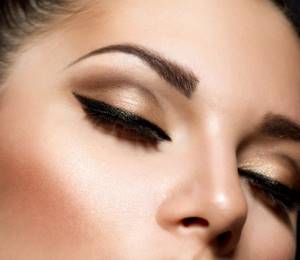
Diligent adherence to the care instructions will reward you with perfect results.
Failed microblading - eyebrow microblading correction
Whether microblading was successful or not will become clear only after 3-4 weeks, when the scabs come off. If the result “exceeded all expectations,” then it is better to correct it in time.
The main reasons for eyebrow correction:
- incorrect shape, incorrectly chosen width;
- inappropriate color;
- incorrectly selected microblading technique;
- non-compliance with post-procedure care rules;
- errors in the work of the master;
- changing the original paint color.
Correction or correction
The wrong way is to fill the shades with flesh color. Then worse problems may appear in the form of unpredictable effects. This method can only be used if the shape is irregular. To correct serious problems, laser correction is required. 1-2 procedures turn eyebrows gray.
The pigment is completely removed in 2-6 procedures . Cream remover allows you to get rid of unsuccessful microblading in 1-2 sessions. A chemical reaction occurs between the cream and the dye, and the substances formed during the reaction are removed from the skin.
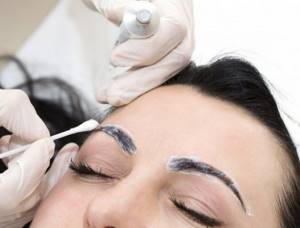
Correction is a complex and slow process. Efficiency depends entirely on the skills of the specialist, the equipment and preparations used. And despite this, each case requires an individual approach. Therefore, it is necessary to do this in professional salons that have a good reputation and have experienced specialists.
In this case, you should no longer focus on the price, which will be considerable. Health and beauty come first!
Advantages and disadvantages of eyebrow microblading
In recent years, microblading has become increasingly popular among girls. This can be explained by the fashion for naturalness (which this procedure can achieve), as well as the following advantages of this technique:
- Possibility of drawing hairs and thereby increasing the volume of eyebrows;
- Minimal pain;
- Minimal skin trauma;
- Lack of a long recovery period;
- Fast execution speed;
- No need for regular correction.
Microblading allows you to forget about pencils, eyebrow liners and long drawings in the morning. But this procedure has several disadvantages:
- Difficulty in finding a specialist (eyebrow drawing using the microblading technique is done manually, so it should only be done by an experienced specialist);
- High cost (due to the complexity of the technology).
About
Microblading training: courses for beginners
If we talk about training courses, they are strikingly different for beginners and professionals. Some already have the skills, while others will have to learn everything from scratch. For beginners, group classes are held at the very beginning so that they learn the basics.
Later, individual lessons with a teacher follow. For professionals, individual training sessions or advanced training courses are provided.
The duration of classes for beginners is usually 2-3 days. All this time they are taught both theory and practice. In practice, they work with artificial skin first, and only finally with live models. Courses are taught in educational institutions or special studios.
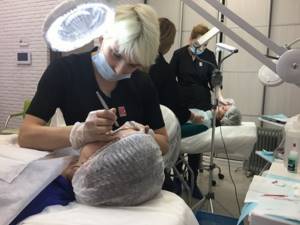
Pre-registration is carried out by telephone. Upon completion of studies, a diploma as a makeup artist is issued. Groups range from 5 to 14 people. Tuition costs $100-140. You can take an individual course, which will cost approximately 2 times more. Everyone chooses what suits them.
Many people get their eyebrows microbladed. Having found out what it is, they leave the most contradictory reviews. Some respond with admiration, others are dissatisfied. And this is normal, since much depends on the hand of the master and the individual reaction of the skin.
